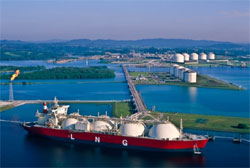A gas cartel looms
on
A gas cartel looms
After years of its members insisting that the Gas Exporting Countries Forum is anything but a cartel, the organisation appears to be on its way to becoming precisely that. How worried should consuming countries in Europe be? Not too worried – yet.
 |
| Qatar's energy minister Al-Attiyah, Iran's energy minister Nozari and Gazprom CEO Miller (from left to right) at a GECF meeting in Tehran, Iran, in October 2008 |
Could it work? Numerous commentators, among them some of the energy ministers of the countries that make up the GECF, have over the years insisted that it could not. Gas, they have argued, is fundamentally different to oil, as are the structures of gas markets and contracts. So it is highly significant – and perhaps ironic – that the call for price support should come from the Algerian Minister Khelil, an influential figure on the global energy stage who spent years working for the World Bank before taking up his ministerial post. Despite the rise of Qatar as the world’s biggest LNG producer, Algeria remains the biggest exporter of natural gas in the Middle East and North Africa, by LNG and through major pipelines to southern Europe. It is unlikely that Khelil would make such a suggestion without having done his homework.
Downward flexibility
There are, in fact, many reasons why a gas cartel would be difficult to implent. In making his announcement at last week’s meeting of OPEC ministers in Vienna, Khelil recognised that any production cuts would necessarily be restricted to spot and short-term gas in traded markets. Most gas is sold under long-term contract. In most cases the downward flexibility provisions in these contracts have already been exercised by buyers faced with drastic demand declines in their home markets.
Indeed, the wide divergence of oil and gas prices in traded markets that we have seen over the past year, has been putting heavy pressure on the oil price-indexation that most such contracts incorporate. Buyers do all they can to be able to source much cheaper gas in the traded markets, as Khelil himself conceded. That is one reason why Gazprom recently agreed to introduce an element of gas-indexation in some of its contracts with Eon Ruhrgas. At the recent Flame gas conference in Amsterdam, Jon A. Jacobsen, senior vice president of manufacturing and marketing at Statoil, said his company had recently ‘modernised’ all of its long-term contracts, modifying them to include more free sourcing for buyers.
Price-supporting production cuts would, therefore, have to be restricted mostly to pipeline gas in north-west Europe and North America and, crucially, those volumes of LNG not covered by long-term contracts. The latter make up about a fifth of the LNG market. A key question therefore is whether LNG producers would be willing to shut-in production to bolster prices. Some, such as BP, have previously indicated a willingness to respond to low prices by taking longer to bring new plant on stream and making maintenance intervals longer than they would otherwise be. But such measures will have only marginal impact given the size of the glut the market faces.
Most producers, crucially the Qataris, have taken the opposite view – and for good reasons. It was significant that the Qatari energy minister, Abdullah bin Hamad Al-Attiyah, who was also in Vienna last week, declined to comment on Khelil’s proposals when questioned by reporters. The view of Faisal Al-Suwaidi, chief executive of Qatargas, the larger of the two Qatari LNG companies, when questioned by European Energy Review last year, was: ‘This is not even on our radar screen. It’s not something we will consider. If someone has to shut down I can assure you it will not be Qatar.’
How low would gas prices have to go before LNG producers would consider shut-ins? That question is far from straightforward. For many projects a key factor will be the associated production of upstream liquids, such as LPG and condensate, particularly with crude prices currently trading at around $80/barrel. With the surprisingly wide divergence of gas and oil prices we have seen over the past year, some producers may decide to bear a small or even negative netback on LNG, if shutting in production means forgoing revenues on lucrative liquids. For example, when Qatar reaches its target of 77 million tonnes/year of LNG production it will also produce around 30 million tonnes/year (220 millon barrels/year) of associated liquids.
Suppliers would not consider shutting in LNG production for economic reasons as long as production can still cover marginal (variable) operating costs. Only those costs would be saved if the liquefaction plant were to shut down. Any revenue that exceeds these variable costs makes some contribution to the fixed costs and therefore the project would be worse off if it shut down. LNG marginal costs can be as low as $0.50/MMBtu, about 12% of the current spot price.
As several commentators, including Alberto Alvarez, commercial director of Repsol Gas Natural LNG (Stream), have pointed out, many of the final investment decisions on the LNG plants now coming on stream were made in the early part of the 2000s, when prices in traded markets were even lower than they are now. Moreover, many LNG projects are project-financed with non-recourse or limited-recourse loans, the terms of which can make it difficult or impossible to shut in production.
Collapse in investment
But there are other arguments too against the idea that an OPEC-style gas cartel is currently feasible, as European Energy Review has previously reported.
- Most gas is currently sold under long-term bilateral contracts between a single seller and a single buyer. These stipulate in detail the delivery terms and the basis of the price, usually with a linkage to oil and/or oil products.
- Gas markets remain regional rather than global, with their own individual physical infrastructures, contracting structures and price formation mechanisms. LNG is having a globalising influence but the pricing linkages between regional markets remain tenuous.
- Gas in its primary market, power generation, can be substituted by coal, nuclear power, renewables or indeed oil, whereas oil's role in transportation is not easily substitutable – leading to relatively inelastic demand.
- Some feel there is little need for a gas cartel as gas producers piggy-back on an existing cartel – OPEC – because most gas contracts are priced on the basis of linkages to oil or oil products.
Nevertheless, the world is changing and the direction it will take is hard to predict right now. If, as some believe, the divergence of oil and gas prices looks likely to persist at least for the next three to four years, the pressures on gas producers to do something to support prices will grow. The alternative will be a collapse in new investment in gas production, as Khelil fears, which would be against the interests of consumers in the long term.
 |
|
LNG tanker docked in port with the liquefaction plant in the background. |
So what are the arguments in favour of the possibility of a gas cartel? While it is true that long-term contracts will form the basis of most gas trades for the foreseeable future, the development of spot and short-term trading, especially in LNG, is accelerating. In some markets, notably the US and the UK, gas-to-gas competition has become the norm, even when gas is delivered by pipeline. Gas markets are becoming increasingly liquid and interlinked. Events in one regional market – whether it be a nuclear shut-down in Japan, or a sudden revival of gas production growth in the US – already can have dramatic and immediate effects on other markets. The example of how LNG business has metamorphosed over the past decade suggests that business-as-usual cannot be assumed in the long term.
And, as we are seeing, protestations by GECF members that their association is not aimed at the formation of a cartel can no longer be taken at face value. As globalisation and liquidity increase, scope for co-operation – and, should the parties so chose, collusion – will broaden. It is worth remembering that more than half of the world’s conventional reserves of gas are under the control of just three countries: Russia, Iran and Qatar.
Much will depend on whether the unconventional gas revolution (see box) turns out to be a flash in the pan, as some believe, or whether it will endure and spread beyond North America into Europe, the Middle East and Asia-Pacific. Indonesia alone estimates that it has 450 Tcf (trillion cubic feet) of coalbed methane reserves, three times its proved and potential reserves of conventional gas. That compares with Qatar’s proved reserves of 900 Tcf.
It will be fascinating to see what transpires at next month’s GECF meeting, which will take place on 19 April. What concrete measures will Khelil put forward to narrow the oil/gas price divergence? What action does Algeria itself proposes to take. Someone will have to take the lead – and Khelil seems to have assumed that role for himself.
|
Unconventional game-changer A key question is how the rise of unconventional gas – which now accounts for more than half of US production, calling into question the term ‘unconventional’ – will affect the prospects of an effective international gas cartel. This impact has been so large that in 2009, the United States overtook Russia to become the world's largest gas producer – unthinkable just three years ago – thanks to its lead in unconventional gas development and also as a result of the demand collapse in Europe, Gazprom’s main export market. The super-majors, who came to the unconventionals party unfashionably late, have been spending billions taking up new positions – witness ExxonMobil's purchase of shale gas producer XTO Energy last year for no less than $32 billion, to give just one example. Some commentators are now forecasting a gas price crash in traded markets this summer that will make last year's lows look like a picnic in the park – as more unconventional gas and a tsunami of new LNG collide with demand declines in recession-battered markets. How all of this will impact the world energy balance, but also the balance of political power, it is still too early to say. The rise of unconventional gas may be hastening the development of a gas cartel in the short term – but in the long term it may make it ineffective. For more stories on the “silent revolution” of unconventional gas, see Surprise, surprise, How gas can change the world and The great potential of unconventional. |


Discussion (0 comments)